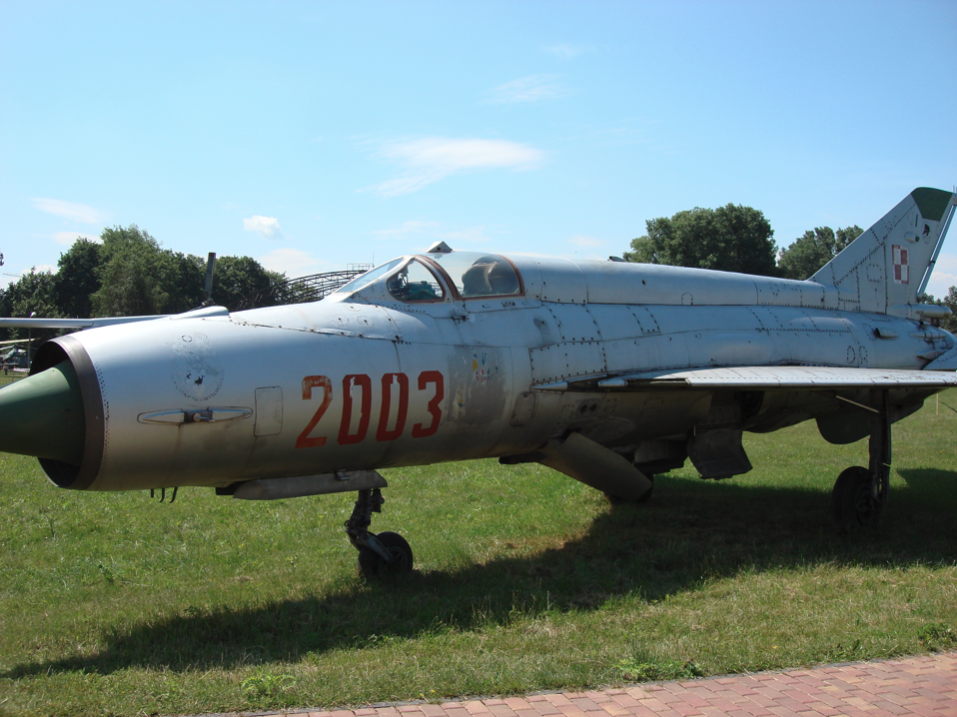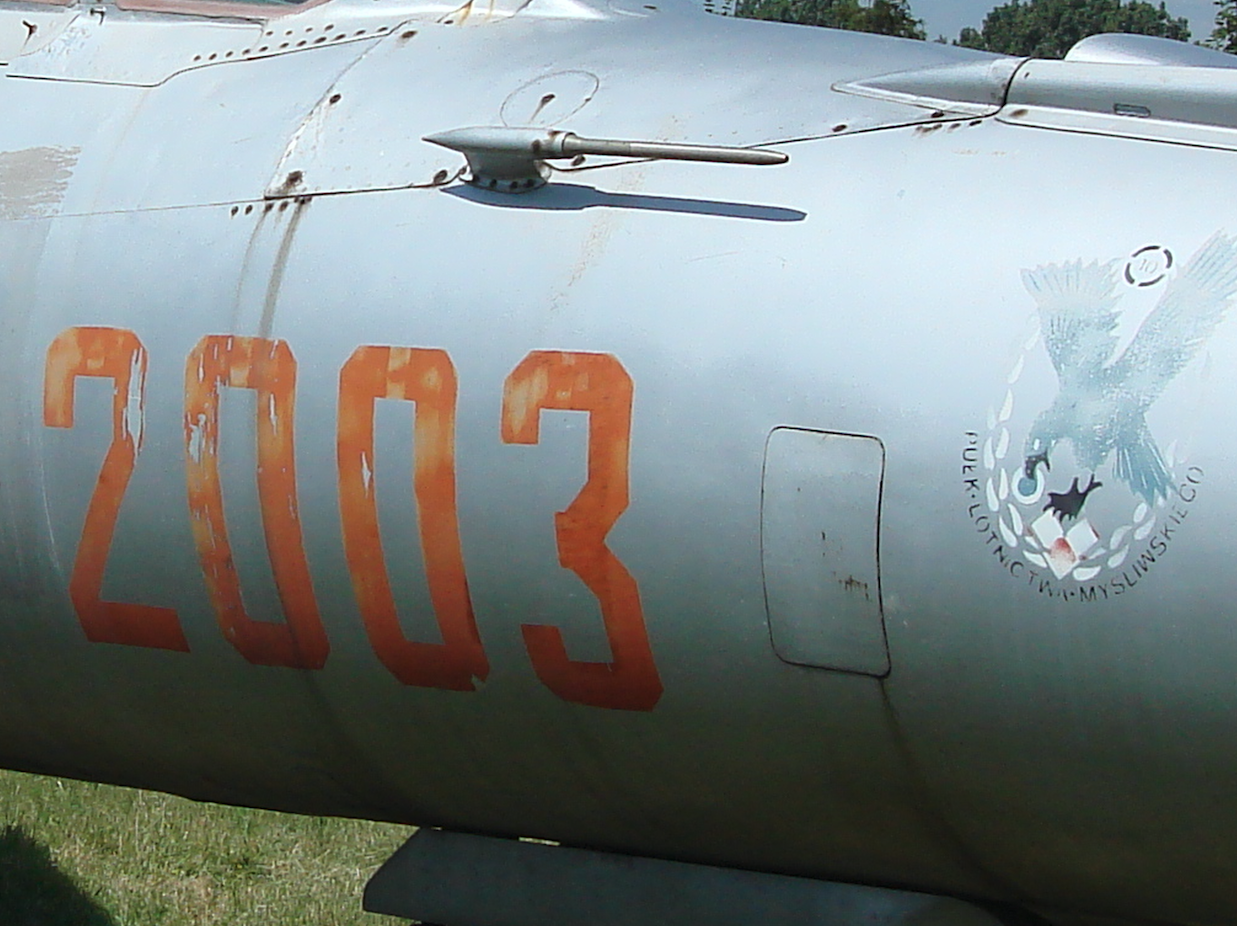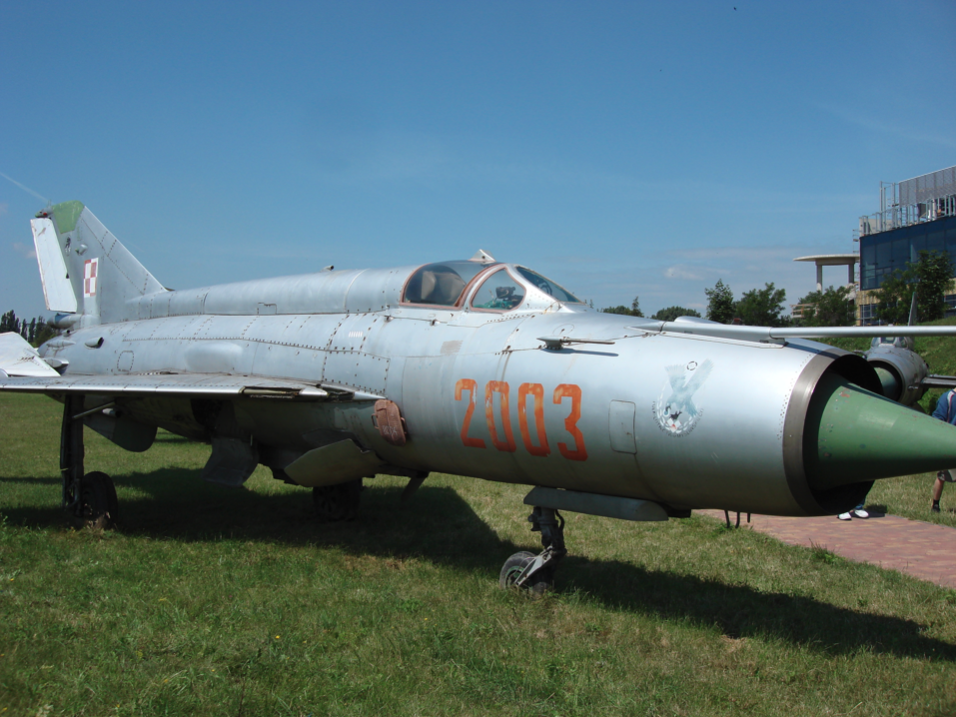Kraków 2009-04-16
History
217b Section 1969-12-30.
OKB Mikojan and Guriewicz MiG-21 M in Poland.
MiG-21 M belongs to the third generation of MiG-21 fighters.




MiG-21 SM/M. 1968.
In 1968, a modernized MiG-21 fighter was built. The machine received the designation MiG-21 SM type 15, E-7 SM. It was equipped with an R-13-300 engine with 1 x 3 990 kG thrust. without afterburning and 1 x 6 360 kG. with afterburning. The GSz-23 Ł double-barrel gun with 200 bullets was permanently installed in the airframe. Armament load increased to 1,300 kg. Under the wings, a second pair of armament hooks were added. The R-832 M radio was installed. The capacity of the fuel system was reduced to 2,685 liters, but it was compensated by a 800 liter suspended tank. The aircraft received an A-39 photo camera. The airframe is equipped with a WRe (for radio-electronic) tank SPS-141 E and ASO-21 ejectors with PRP-26 cartridges and PPI-26 thermal traps.
The new engine improved performance, ground speed increased from 1,200 km / h to 1,300 km / h. During production, the reinforced R-13-300 engine with 1 x 4 010 thrust was installed, and with 1 x 6 478 kG afterburning.
The aircraft was produced at CCCP in Gorki in 1968-1974, only for the needs of the Red Army.
MiG-21 M is the lean version of the MiG-21 SM. The MiG-21 M type 96, E-7 M aircraft received the R-11 F2S-300 or R-11 F2SK-300 engine, the R-802 W radio. The aircraft was manufactured for export in Moscow in the years 1968-1971. The license was sold to India in 1971.
MiG-21 M in Poland. 1969.
On December 30, 1969, Poland received the first 6 copies of the new MiG-21 M aircraft. Their introduction allowed the decommissioning of the first supersonic aircraft of the Polish Aviation MiG-19P / PM and MiG-21F-13. Deliveries were completed in 1971. Poland purchased a total of 36 MiG-21 M aircraft.
Polish aircraft were delivered in an impoverished version; R-11 F2S-300 engines, RP-21 radar station, RS-2 US missiles.
The first machines went to CSL in Modlin. The first combat unit that received the MiG-21 M was 41 PLM in Malbork. This version was also included in the armament of 1 PLM in Mińsk Mazowiecki and 26 PLM (and since 1989, 9 PLM) in Zegrze Pomorskie.
In August and September 1985, two MiG-21 M aircraft No. 96 A 1901, 96 A 1913, which previously served in 26 PLM, went to 10 PLM.
In 1990, there were still 27 aircraft in service, and in 2000, 15 more. During the 30 years of operation, 12 machines were lost in accidents (1 in a disaster, 9 in failures, 2 damaged).
In 1993, another MiG-21 M went to 10 PLM in Łask. In 1995-1999, planes from Mińsk Mazowiecki, Malbork and Wrocław were accepted. Here, MiG-21 M planes (after medium and major repairs carried out in previous years), ended their lives. Exactly after 30 years of service, MiG-21 M aircraft were withdrawn from operations and removed from the state.

Why did Poland buy the depleted version of MiG-21 M and then MiG-21 MF ?
The question seems strange, but not meaningless. For many years we thought that the Soviets did not want to give us newer equipment. That it took at least 5 years for us to receive the next version. In the 90’s it came to light that the Soviets would sell us every aircraft they had brought into their armament, only that our country could not afford such expenses. However, this is another translation that does not reflect the essence of the matter. We will try to bring the problem of buying more MiG-21 aircraft in the light of the latest analyzes.
At the end of the 1960s, to be precise in 1967, the Soviets based on the MiG-21 PFM (94) developed the reconnaissance fighter MiG-21 R (E7R, 94R). The MiG-21 S (95) fighters were developed almost together with it. This aircraft received; enlarged over-fuselage fuel tank (as in the MiG-21 R), four armament hooks under the fuselage (as in the MiG-21 R), new radar station. After a few months the plane received; new R-13 F-300 engine, GSz-23 Ł sub-fuselage fixed cannon and received the designation MiG-21 SM (95 M). On the basis of this construction, the MiG-21 M versions were developed, and a little later MiG-21 MF intended mainly for export. Against this background, Poland bought MiG-21 M fighters with R-11 engines, i.e. older ones and older weapons and equipment.
From the perspective of many years, we consider the purchase of these aircraft appropriate and justified. Why? The turn of the 60s / 70s was not peaceful in the world. There were wars in Vietnam and the Middle East. The Americans gained an advantage in rocket technology and set foot on the moon. Fighter aviation was at a crossroads; whether to go in the direction of variable geometry planes or to build uprights. Poland was bogged down in a planned economy, in a permanent crisis with inefficient authorities at the top. Workers’ protests in 1970 resulted in a partial reduction of military spending and the allocation of additional funds for the development of civilian economy.
The purchase of the MiG-21 M with R-11 engines was a unification of the power unit with the MiG-21 PFM version, of which we purchased as many as 132 pieces, plus a significant number of spare parts, including engines. We could not have foreseen that the Soviets would modernize this construction for so many years.
Modernization and armament of MiG-21 M in Poland.
Until the end of 1980, MiG-21 M / MF planes were on standby duty; 2 x RS-2 US + 2 x R-3 S + 200 ammunition for cannons. In 1981, this was changed and the duty crew were exhibited so that one aircraft had 2 x RS-2 US and the other had 2 x R-3 S. An additional pair of missiles was placed on the aircraft stands. Cannon ammunition remained unchanged. The pilots themselves did not quite understand this change, but it introduced confusingly.
In 1985, in ITWL, in consultation with OKB Mikojana, arming of MiG-21 M aircraft in the CCP began. p-p class R-60. At that time it was the basic missile of MiG-21 bis fighters. The electrical installation and suspension for the APU-60 launcher had to change. There was no change in the cabin alone. The main works were carried out at the Air Force Institute of Technology, and the tests were carried out at the 45th Air Experimental Squadron. The result of the work was positive and significantly increased the combat capabilities of the MiG-21 M. All Polish MiG-21 M aircraft were modernized. To see what the introduction of R-60 missiles meant for the MiG-21 M, let’s compare it with the R-3 S;
For the R-60 missile;
Maximum aircraft overload during a shot 7.0 g (without slide), 5.0 g (with slide).
The minimum firing distance from the target is 0.2-0.3 km (combat conditions), 0.6-0.7 km (during exercise).
Target bearing maximum angle is 40 degrees.
Maximum speed of automatic target tracking through the R-60 warhead – 30 degrees / s.
For the R-3 S missile;
Maximum aircraft overload during a shot 2.0 g (up to a ceiling of 12,000 m), 1.8 g (over 12,000 m).
Target bearing target angle is 28 degrees.
Maximum speed of automatic target tracking through the R-3 S self-guiding head – 6 degrees / s.
We see the huge difference in the capabilities of both missiles. With the R-60 you could really lead a maneuvering fight.
When writing about the Code of Civil Procedure mention should be made of the double Monsoon launcher. This launcher was developed for the CCP R-3 S and allowed the MiG-21 PFM / PF fighter to carry 4 of these missiles, although it required modernization of the electrical installation. Monsun launchers also carried MiG-21 M aircraft, in which the electrical installation was not changed. The package firing control switch for the MiG-21 M is firing missiles individually (1-2-3-4 launchers) or 1-2 or 3-4 salvo. In the case of suspending a double launcher, the same happens except that there is a blockade on the launcher itself. As soon as one bullet descends, the automation switches to the other. So in the case of firing, the salvo will be 2 x salvo from external 3-4 (pressing the combat button twice).
Some Polish MiG-21 M and MiG-21 MF planes carried Ch-66 (H-66) air-to-ground missiles.
Written by Karol Placha Hetman
